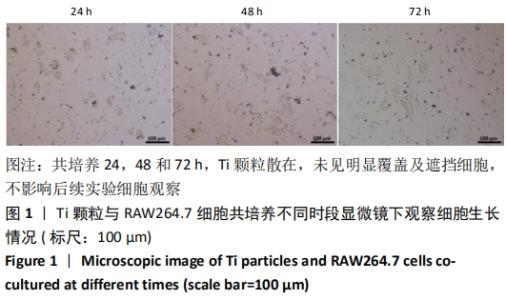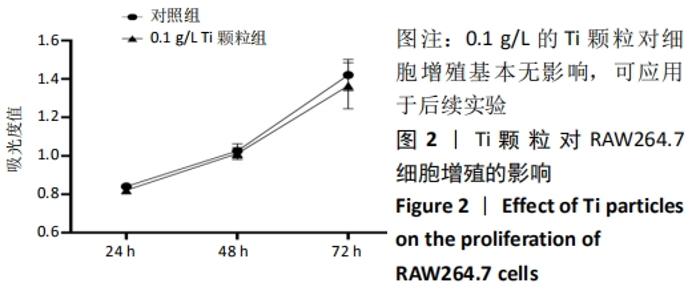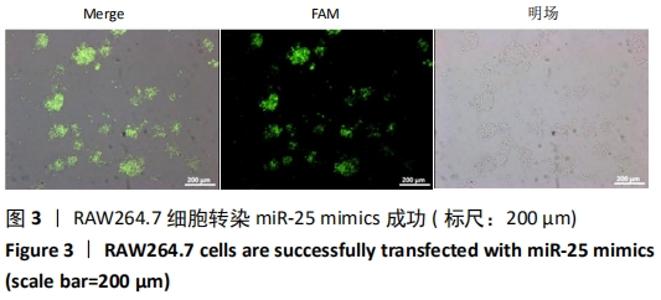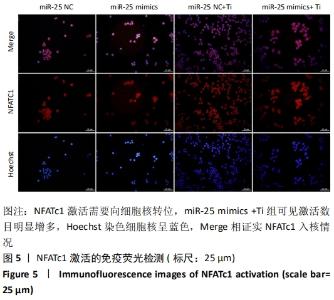Chinese Journal of Tissue Engineering Research ›› 2022, Vol. 26 ›› Issue (5): 682-687.doi: 10.12307/2022.111
Previous Articles Next Articles
Overexpression of miR-25 downregulates titanium particle-induced osteoclast differentiation through the NFATc1 signaling pathway
Hu Weifan1, Zheng Li1, Li Dadi1, Sun Yang1, Zhao Fengchao2
- 1Graduate School of Xuzhou Medical University, Xuzhou 221000, Jiangsu Province, China; 2Department of Orthopedics, Affiliated Hospital of Xuzhou Medical University, Xuzhou 221000, Jiangsu Province, China
-
Received:2020-10-22Revised:2020-10-24Accepted:2020-11-26Online:2022-02-18Published:2021-10-28 -
Contact:Zhao Fengchao, MD, Chief physician, Department of Orthopedics, Affiliated Hospital of Xuzhou Medical University, Xuzhou 221000, Jiangsu Province, China -
About author:Hu Weifan, Master candidate, Graduate School of Xuzhou Medical University, Xuzhou 221000, Jiangsu Province, China
CLC Number:
Cite this article
Hu Weifan, Zheng Li, Li Dadi, Sun Yang, Zhao Fengchao. Overexpression of miR-25 downregulates titanium particle-induced osteoclast differentiation through the NFATc1 signaling pathway[J]. Chinese Journal of Tissue Engineering Research, 2022, 26(5): 682-687.
share this article
Add to citation manager EndNote|Reference Manager|ProCite|BibTeX|RefWorks
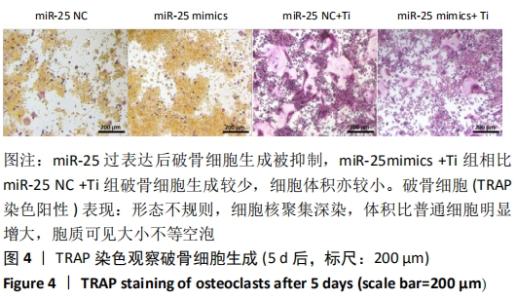
加入Ti颗粒共培养,5 d后显微镜下观察破骨细胞分化情况:无Ti颗粒诱导组基本未见破骨细胞生成,可见单纯miR-25 NC以及miR-25 mimics对RAW264.7细胞向破骨细胞分化无影响作用;经过Ti颗粒诱导后,miR-25 NC+Ti组及miR-25 mimics+Ti组均出现了TRAP染色阳性多核破骨细胞,miR-25 NC+Ti组破骨细胞体积相对较大,细胞数目较多,miR-25 mimics+Ti组破骨细胞体积相对较小,细胞数亦较少,见图4。镜下观察并计数,结果表明200倍镜下每孔破骨细胞数:miR-25 NC组为1.07±0.15,miR-25 mimics 组为0.47±0.25,miR-25 NC+Ti组为43.33±4.04,miR-25 mimics+Ti组为20.67±2.52,与miR-25 NC组比,miR-25 mimics+Ti组破骨细胞生成显著下降52.30%(P < 0.05)。"


2.4 miR-25过表达后对破骨细胞分化通路中相关信号分子表达的影响 为明确miR-25过表达影响破骨细胞分化的相关机制,对于Ca2+/NFATc1信号通路中相关因子进行了检测。共培养5 d后收获各组细胞,行RT-PCR 检测,以β-actin为内参,测定各组细胞NFATc1、CaMKⅡ、CaMKⅣ mRNA的相对表达量,4组间各基因相对表达量差异有显著性意义;两两比较结果发现,相对于miR-25 NC+Ti组,在miR-25mimics+Ti 组,miR-25过表达后, NFATc1受到影响,激活减少,NFATc1 mRNA降低明显(P < 0.005),CaMKⅡmRNA水平降低(P < 0.005),CaMKⅣmRNA的表达量也明显降低(P < 0.000 1),见表2。"

| [1] JONAS K, NILS W, ALEXANDER D, et al. The etiology of revision total hip arthroplasty: current trends in a retrospective survey of 3450 cases. Arch Orthop Trauma Surg. 2020;140(9):1265-1273. [2] KHATOD M, CAFRI G, INACIO MC, et al. Revision Total Hip Arthoplasty: Factors Associated with Re-Revision Surgery. J Bone Joint Surg Am. 2015;97(5):359-366. [3] KENNEY C, DICK S, LEA J, et al. A systematic review of the causes of failure of Revision Total Hip Arthroplasty. J Orthop. 2019;16(5):393-395. [4] SUNDFELDT M, CARLSSON LV, JOHANSSON CB, et al. Aseptic loosening, not only a question of wear: a review of different theories. Acta Orthop. 2006;77(2):177-197. [5] GOODMAN SB, GALLO J, GIBON E, et al. Diagnosis and management of implant debris-associated inflammation. Expert Rev Med Devices. 2020;17(1):41-56. [6] NEGISHI-KOGA T, TAKAYANAGI H. Ca2+-NFATc1 signaling is an essential axis of osteoclast differentiation. Immunol Rev. 2009;231(1):241-56. [7] Ha M, Kim VN. Regulation of microRNA biogenesis. Nat Rev Mol Cell Biol. 2014;15(8):509-524. [8] ONO K, HORIE T, NISHINO T, et al. MicroRNAs and High-Density Lipoprotein Cholesterol Metabolism. Int Heart J. 2015;56(4):365-371. [9] DIRKX E, GLADKA MM, PHILIPPEN LE, et al. Nfat and miR-25 cooperate to reactivate the transcription factor Hand2 in heart failure. Nat Cell Biol. 2013;15(11):1282-1293. [10] YAO Y, SUN WD, SUN QF, et al. Platelet-Derived Exosomal MicroRNA-25-3p Inhibits Coronary Vascular Endothelial Cell Inflammation Through Adam10 via the NF-κB Signaling Pathway in ApoE Mice. Front Immunol. 2019;10(1):2205. [11] ZHANG JF, SHI LL, ZHANG L, et al. MicroRNA-25 Negatively Regulates Cerebral Ischemia/Reperfusion Injury-Induced Cell Apoptosis Through Fas/FasL Pathway. J Mol Neurosci. 2016;58(4):507-516. [12] Mehlich D, Garbicz F, Włodarski PK. The emerging roles of the polycistronic miR-106b~25 cluster in cancer - A comprehensive review. Biomed Pharmacother. 2018;107(1):1183-1195. [13] HUANG YZ, REN KY, YAO T, et al. MicroRNA-25-3p regulates osteoclasts through nuclear factor I X.Biochem Biophys Res Commun. 2020;522(1): 74-80. [14] LIU XQ, QU XH, WU Cl, et al. The effect of enoxacin on osteoclastogenesis and reduction of titanium particle-induced osteolysis via suppression of JNK signaling pathway. Biomaterials. 2014;35(22):5721-5230. [15] ZHANG YY, LIN Y, XIAO LL, et al. The effects of icariine concentration on osteoclasts bone resorption induced by titanium particles in vitro. Regen Biomater. 2015;2(3):197-202. [16] LEE SS, WOO CH, CHANG JD, et al. Roles of Rac and cytosolic phospholipase A2 in the intracellular signalling in response to titanium particles. Cell Signal. 2003;15(3):339-345. [17] HOLT G, MURNAGHAN C, REILLY J, et al. The biology of aseptic osteolysis. Clin Orthop Relat Res. 2007;460(1):240-252. [18] TANAKA S, NAKAMURA K, TAKAHASI N, et al. Role of RANKL in physiological and pathological bone resorption and therapeutics targeting the RANKL-RANK signaling system. Immunol Rev. 2005; 208(1):30-49. [19] FURUYA Y, MORI K, NINOMIYA T, et al. Increased bone mass in mice after single injection of anti-receptor activator of nuclear factor-kappaB ligand-neutralizing antibody: evidence for bone anabolic effect of parathyroid hormone in mice with few osteoclasts. J Biol Chem. 2011;286(42):37023-37031. [20] YAMAKAWA Y, TAZAWA H, HASEI J, et al. Role of zoledronic acid in oncolytic virotherapy: Promotion of antitumor effect and prevention of bone destruction. Cancer Sci. 2017;108(9):1870-1880. [21] CHAVARRY NGM, PERRONE D, FARIAS MLF, et al. Alendronate improves bone density and type I collagen accumulation but increases the amount of pentosidine in the healing dental alveolus of ovariectomized rabbits. Bone. 2019;120(1):9-19. [22] SON A, KANG N, OH SY, et al. Homer2 and Homer3 modulate RANKL-induced NFATc1 signaling in osteoclastogenesis and bone metabolism. J Endocrinol. 2019;242(3):241-249. [23] SONG MK, PARK C, LEE YD, et al. Gα12 regulates osteoclastogenesis by modulating NFATc1 expression. J Cell Mol Med. 2018;22(2):849-860. [24] KROL J, LOEDIGE I, FILIPOWICZ W. The widespread regulation of microRNA biogenesis, function and decay. Nat Rev Genet. 2010;11(9): 597-610. [25] CONG C, TIAN J, GAO T, et al. lncRNA GAS5 Is Upregulated in Osteoporosis and Downregulates miR-21 to Promote Apoptosis of Osteoclasts. Clin Interv Aging. 2020;15(1):1163-1169. [26] MOUSSA FM, COOK BP, SONDAG GR, et al. The role of miR-150 regulates bone cell differentiation and function. Bone. 2020; undefined:115470. [27] GAASCH JA, BOLWAHNN AB, LINDSEY JS. Hepatocyte growth factor-regulated genes in differentiated RAW 264.7 osteoclast and undifferentiated cells. Gene. 2006;369(1):142-152. [28] LEE SS, WOO CH, CHANG JD, et al. Roles of Rac and cytosolic phospholipase A2 in the intracellular signalling in response to titanium particles. Cell Signal. 2003;15(3):339-345. [29] KANG JY, KANG N, YANG YM, et al. The Role of Ca-NFATc1 Signaling and Its Modulation on Osteoclastogenesis. Int J Mol Sci. 2020;21(10):3646. [30] TAKAYANAGI H, KIM S, KOGA T, et al. Induction and activation of the transcription factor NFATc1 (NFAT2) integrate RANKL signaling in terminal differentiation of osteoclasts. Dev Cell. 2002;3(6):889-901. [31] LIU FX, ZHU ZN, MAO YQ, et al. Inhibition of titanium particle-induced osteoclastogenesis through inactivation of NFATc1 by VIVIT peptide. Biomaterials. 2009;30(9):1756-1762. [32] DA COSTA MARTINS PA, SALIC K, GLADKA MM, et al. MicroRNA-199b targets the nuclear kinase Dyrk1a in an auto-amplification loop promoting calcineurin/NFAT signalling. Nat Cell Biol. 2010;12(12): 1220-1227. [33] SATO K, SUEMATSU A, NAKASHIMA T, et al. Regulation of osteoclast differentiation and function by the CaMK-CREB pathway. Nat Med. 2006;12(12):1410-1416. [34] CHANG EJ, HA J, HUANG H, et al. The JNK-dependent CaMK pathway restrains the reversion of committed cells during osteoclast differentiation. J Cell Sci. 2008;121(15):2555-2564. [35] PAN L, HUANG BJ, MA XE, et al. MiR-25 protects cardiomyocytes against oxidative damage by targeting the mitochondrial calcium uniporter. Int J Mol Sci. 2015;16(3):5420-5433. |
| [1] | Wang Jing, Xiong Shan, Cao Jin, Feng Linwei, Wang Xin. Role and mechanism of interleukin-3 in bone metabolism [J]. Chinese Journal of Tissue Engineering Research, 2022, 26(8): 1260-1265. |
| [2] | Xiao Hao, Liu Jing, Zhou Jun. Research progress of pulsed electromagnetic field in the treatment of postmenopausal osteoporosis [J]. Chinese Journal of Tissue Engineering Research, 2022, 26(8): 1266-1271. |
| [3] | Wu Saixuan, Zhang Mi, Dong Ming, Lu Ying, Niu Weidong. Regulatory role of Keap1/Nrf2/ARE signaling pathway in bone homeostasis [J]. Chinese Journal of Tissue Engineering Research, 2022, 26(2): 271-275. |
| [4] | Sun Youqiang, Ma Chao, Liang Mengmeng, Xin Pengfei, Zhang Hua, Xiang Xiaobing. The pivotal role of autophagy in bone cells: bone-related cell activity and bone metabolism [J]. Chinese Journal of Tissue Engineering Research, 2022, 26(2): 276-282. |
| [5] | Fan Danyang, Fu Runze, Mi Jiajing, Liu Chunyan. Expression and role of cannabinoid receptors during bone remodeling [J]. Chinese Journal of Tissue Engineering Research, 2022, 26(2): 283-288. |
| [6] | Wang Jiajia, Liu Jie, Wang Min. Establishing a murine model of experimental apical periodontitis induced by Fusobacterium nucleatum [J]. Chinese Journal of Tissue Engineering Research, 2022, 26(2): 176-181. |
| [7] | Wang Weiwei, Ou Zhixue, Zhang Xiaoyun, Li Shibin, Zhou Yi, Li Tong. Regulatory mechanism of exosomes in signal communication network of steroid induced avascular necrosis of the femoral head repair [J]. Chinese Journal of Tissue Engineering Research, 2022, 26(19): 3056-3064. |
| [8] | Huang Fayi, Liu Yuhao, Zhou Chi, Huang Haoran, Chen Weijian, He Wei, Wang Haibin. Belamcandin inhibits osteoclast differentiation: its role and mechanism [J]. Chinese Journal of Tissue Engineering Research, 2022, 26(17): 2636-2641. |
| [9] | Tian Xinbao, Xu Jianfeng, Huang Yuan, Lai Zheying, Li Xiaolong, Liu Xiaoli, Lin Ruizhu, Zhu Ning. Internal heat-type acupuncture inhibits osteoblast viability and promotes bone formation in a rat model of steroid-induced avascular necrosis of the femoral head [J]. Chinese Journal of Tissue Engineering Research, 2022, 26(17): 2642-2648. |
| [10] | Huo Hua, Liu Guanjuan, Song Na, Zhou Qian, Cheng Yuting, Luo Shanshan, Liao Jian. Effects of zoledronic acid on alveolar bone metabolism and nucleotide-binding oligomerization domain-like receptor protein 3 inflammasome in the alveolar bone of ovariectomized osteoporosis rats [J]. Chinese Journal of Tissue Engineering Research, 2022, 26(17): 2660-2666. |
| [11] | Cheng Yi, Liu Ting, Guo Yujing, Sun Xiaotong, Bi Lan, Zhang Ronghe. Effect of estrogen on bone remodeling and root resorption during orthodontics [J]. Chinese Journal of Tissue Engineering Research, 2022, 26(17): 2782-2788. |
| [12] | Feng Zhiguo, Sun Haibiao, Han Xiaoqiang. Regulation of proliferation, differentiation and apoptosis of bone-related cells by long-stranded non-coding RNA [J]. Chinese Journal of Tissue Engineering Research, 2022, 26(1): 112-118. |
| [13] | Wang Jing, Lang Xuemei, Wang Weiqun, Zhang Hanxiang, Zhang Yi, Wang Xin. Participation and regulatory mechanism of interleukin-1 during bone metabolism [J]. Chinese Journal of Tissue Engineering Research, 2021, 25(36): 5851-5858. |
| [14] | Zhou Quan, Zhang Yanan, Bai Yiguang, Zhang Qiong, Nong Haibin, Liu Mingfu, Zeng Gaofeng, Zong Shaohui. Effect of 3-phosphoinositide-dependent protein kinase 1 regulating osteoclasts on bone mineral density in osteoporotic mice [J]. Chinese Journal of Tissue Engineering Research, 2021, 25(29): 4680-4684. |
| [15] | He Yixiang, Zhao Yuhao, Gao Zhao, Zhao Haiyan, Wang Wenji. Effect of B lymphocytes and related cytokines on osteoclast differentiation in the osteoimmunology system [J]. Chinese Journal of Tissue Engineering Research, 2021, 25(29): 4709-4714. |
| Viewed | ||||||
|
Full text |
|
|||||
|
Abstract |
|
|||||
